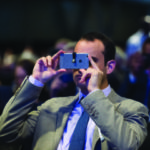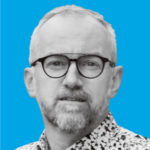
How do you bring together people from around the world who are the heart and soul of the Internet, dedicated to its open development and universal accessibility? The Internet Society answered that question with InterCommunity 2015, the organization’s first global meeting of members, held “on the Internet for the Internet” this past July.
The one-day hybrid event was hosted live from the society’s annual Board of Trustees meeting at the SKY-CITY Hotel in Auckland, New Zealand, with 2,500 members in 141 countries participating. To accommodate different time zones, the first global session was held from 8 a.m. to 10:45 a.m. Auckland time, with a second, identical session beginning in Auckland at 6 p.m. The complex matrix of connection involved 15 regional “nodes” in cities around the world, where members gathered in groups. Nodes could interact with each other as well as with the host site in Auckland. Individuals with an Internet connection also could participate from anywhere in the world. Registration was free, but Internet Society membership (which is free for individuals) was required.
“Just a few years ago, it would have been virtually unthinkable to use Internet technology in this way,” Kathryn Brown, president and CEO of the Internet Society, said in a statement after InterCommunity, “but with the help of a robust network in a New Zealand hotel ballroom and using widely available, affordable applications, we were able to provide numerous ways to connect and communicate between the nodes and from anywhere with a browser. Indeed, we reasserted the agility of the Internet in supporting this kind of interactivity and extent of global engagement. In this sense, the Internet itself is its own greatest champion.”
DESIGNING THE PROGRAM
One of the biggest challenges for InterCommunity’s organizers was coming up with a design and an agenda that would drive engagement of the Internet Society’s diverse membership, who not only are spread across the globe but are involved in many different aspects of the Internet. Founded 23 years ago by Vint Cerf and Bob Kahn — two “fathers of the Internet” — the society began as a not-for-profit organization to support Internet standards development. It continues in that role today as the administrative home for the Internet Engineering Task Force, and is also involved in a range of activities related to Internet technology, public policy, and access and development. With headquarters offices in Reston, Virginia, and Geneva, Switzerland, the Internet Society now has an international membership of more than 140 organizations, 78,000 individual members, and 111 chapters worldwide.
Designing a meeting that would address the society’s multiple communities became the task of Ruud Janssen, CMM, DES, a Swiss-based entrepreneur and co-founder of Event Model Generation (EMG), an event-design training organization whose #EventCanvas is a visual template for strategically developing conference models and measuring outcomes. “The Internet Society is very much a bottom-up organization,” Janssen told Convene, “so it was really important to have inputs from the ground up and across the wide range of communities.”

Using the #EventCanvas framework, “we synthesized inputs from dozens of people,” Janssen said, “and from there were able to drill down to six core stakeholder groups, mapping out needs, goals, and metrics for each of them.” One result was the emergence of three key areas of discussion for the meeting: Internet governance, improving security and trust on the Internet, and ensuring Internet access for everyone in the world.
InterCommunity chose Digitell to stream the event, integrating with Zoom’s virtual meeting platform. Zoom is robust, simple, and offers excellent scalability, according to Janssen. “But of course,” he said, “you always have to design backup plans around potential technical glitches.”
Given the ambitious scope, technical logistics, relatively short, six-month planning window, and other factors, projections for the first-ever event were modest, but in the end “we far exceeded expectations,” Janssen said. “Stakeholders, even those on the technical side, were surprised and flabbergasted to experience what an Internet event could be. InterCommunity 2015 set a different benchmark.”
CREATING ENGAGEMENT
Nicole Armstrong, CMP, CMM, Reston-based senior events manager for the Internet Society, echoes Janssen. “We knew we weren’t going to get everything right,” she said, “but we also knew that using the Internet to bring our community together across different time zones, languages, and cultures was incredibly worthwhile. And when it was over, I sensed a great optimism and excitement from participants, people realizing they could use this model, use the Internet itself, to build connection.”
Planning and executing an Internet event was “surprisingly different, at every turn, from organizing a face-to-face meeting,” Armstrong said. Beyond the technical challenges, which were spearheaded by the society’s senior director of IT development, Todd Tolbert, the key difference was the overriding importance of driving engagement. The first challenge in that regard was language. InterCommunity was conducted in English, with live audio streams available in Spanish and French. “The Internet’s span is global, and our stakeholders reflect that global reach and are heavily regionally focused,” Armstrong said, “so it’s a hard, ongoing challenge to deliver in all the languages of our community.”
InterCommunity allowed individual viewers who were not physically present at one of the 15 regional nodes to engage through a chat tool within the event’s interface, and to participate in polling and surveys using the app Social Q&A. Attendees at regional nodes could interact with each other and, in most cases, with other nodes, as well as with the Auckland host site. The Internet Society used small touches and details to build community identity, from kicking off the program by showing individuals from around the world holding identical photo frames branded with the InterCommunity logo, to ending each of the two global sessions by having participants at the host and remote locations simultaneously launch paper airplanes.
“At one point during the first global session, we could see on our screen in Auckland members in nine cities around the world,” Armstrong said. “I think experiencing the reality of our global community was one of the most exciting takeaways for everyone.”



